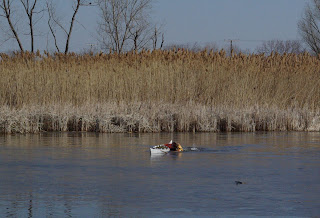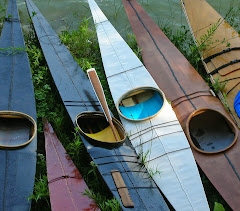After getting the kayak home I finished the stem plates and sanded some rough edges.

Then I took it over to Chuck and he shrink wrapped it for me.

But it would have to wait a week while I went to Florida for a little Relaxation and Sunshine!

I was originally going to go to a pool session, but that didn't work out. So Allan and I decided to take our kayaks to Metro Beach for the test. When we got to our usual launch it was full of ice chunks. So we went over to the boat ramp and found some open water.
 There was still ice out there so I just had a narrow space to go back and forth in front of the launch.
There was still ice out there so I just had a narrow space to go back and forth in front of the launch.
It didn't take me too long to get comfortable and want to do more. Since the ice seemed thin I decided to cross the channel and break up the ice. Such a bad idea.
 Did you notice I'm not wearing gloves? Forgot them at home.
Did you notice I'm not wearing gloves? Forgot them at home. I also forgot how fragile the shrink wrap is. Didn't take long for the ice to rip holes right into it.
I also forgot how fragile the shrink wrap is. Didn't take long for the ice to rip holes right into it.
So the kayak started to fill with water and became unmanueverable. It was like slow motion and I knew I was going over, I was halfway out before I went under!
I tried pushing the boat, but it was full of water and sooo heavy I wasn't getting anywhere.

So I moved to the bow and tried pulling it, which was also slow going. This was very frustrating and I thought about leaving the kayak and just getting out of the cold water.

Allan had his dry suit on, so he jumped in to help...and swam right by me! Apparantly his boots had not been tightly secured and they were floating away.

I then decided it was time to get my hands out of the water, so I finally put the paddle in the cockpit and moved back down to the stern to get them out and on top of the kayak.

We finally made it to shore, look Allan has both his boots. But his zipper had not been zipped all the way and his drysuit was full of water! My hands had never been so cold! I had a drysuit on, so my core temp stayed warm. Thank you Chuck for helping me warm my hands and of course for documenting the whole thing!
My hands had never been so cold! I had a drysuit on, so my core temp stayed warm. Thank you Chuck for helping me warm my hands and of course for documenting the whole thing!

 My hands had never been so cold! I had a drysuit on, so my core temp stayed warm. Thank you Chuck for helping me warm my hands and of course for documenting the whole thing!
My hands had never been so cold! I had a drysuit on, so my core temp stayed warm. Thank you Chuck for helping me warm my hands and of course for documenting the whole thing!
I had to cut a hole in the shrink wrap so we could fully drain the kayak.
I did have one float bag in the front, but not the back. I have to make that one to fit the narrow lenth of the kayak.

Overall I liked the fit of the kayak in the short time I paddled it. I do think the masik is too high, it doesn't make contact with my legs when I'm sitting. I might think about making a new one. Fortunately I didn't have any trouble with the wet exit. So no need to remake the one deck beam that was supposed to be curved for easy entrance and exit.











 This is a view of the bow stem plate pegged into place.
This is a view of the bow stem plate pegged into place.  Here is Danielle sewing a rim or flange onto her cockpit coaming. This will create a ledge for the sprayskirt to grab onto. The coamings have to be steamed and bent around a frame. Chuck is going to do this for all of us as we don't have a lot of coaming stock. Fine with me, since we only have one more day to work in the shop. I've been working on shaping my masik at home so I can peg it into place next weekend. I also shaped the chines, which run the length of the kayak between the keelson and the gunwales.
Here is Danielle sewing a rim or flange onto her cockpit coaming. This will create a ledge for the sprayskirt to grab onto. The coamings have to be steamed and bent around a frame. Chuck is going to do this for all of us as we don't have a lot of coaming stock. Fine with me, since we only have one more day to work in the shop. I've been working on shaping my masik at home so I can peg it into place next weekend. I also shaped the chines, which run the length of the kayak between the keelson and the gunwales.







 I attatched the keelson to the stem pieces by pegging it into place. First I added a strip to build up the stern area, it needed a little more depth.
I attatched the keelson to the stem pieces by pegging it into place. First I added a strip to build up the stern area, it needed a little more depth.




 Here is an oak log that was used to cut ribs from. You can see some of them on the right, we keep them covered and damp so they stay pliable.
Here is an oak log that was used to cut ribs from. You can see some of them on the right, we keep them covered and damp so they stay pliable.

 Then I got my hands on the green ribs and everything fell into place, it was like night and day. And then it was late at night and time to go home.
Then I got my hands on the green ribs and everything fell into place, it was like night and day. And then it was late at night and time to go home.









